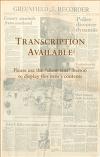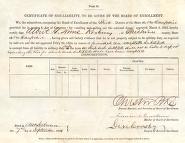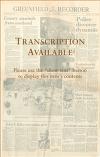|

"War Protest Keeps New England College Campuses in Ferment" article in The Greenfield Recorder newspaper

Civil War Certificate of Non-Liability for Substitute

"Counting Our Blessings!" cartoon from The Greenfield Recorder newspaper

"Hippies and the War" editorial from The Greenfield Recorder newspaper
|
Summary and Objective
Students will understand that the concept of 'war protest' is not unique to any one historical period or conflict. Students will demonstrate their understanding by analyzing materials from the Civil War and Vietnam eras.
Teaching Plan
Step 1.
Students will have studied the American Civil War and have some prior knowledge of the Vietnam War.
This activity may be done individually or in small groups.
Step 2.
Students will read the lyrics to the songs "Where Have All the Flowers Gone" (http://www.arlo.net/resources/lyrics/flowers-gone.shtml) and "All Quiet Along the Potomac" (handout) without the song titles. Students will hypothesize which song pertains to which war and answer the following questions for each song: from whose perspective was it written? what is the narrative of the song? what is the underlying theme or message of the song?
Step 3.
Students will examine government draft documents from both the Civil War and Vietnam, then compare and contrast materials illustrating opposition to the war in general and the draft in particular.
For Vietnam, students will read "War Protests keep New England College Campuses in Ferment," and "Hippies and the War" and view the cartoon,"One Good Reason...". For the Civil War, students will examine the "Charge of the Police on the Rioters at the TRIBUNE Office" http://www.sonofthesouth.net/leefoundation/civil-war/1863/august/draft-riots.htm and read the lyrics to the song "We Are Coming Father Abraham."
For each source (not the draft cards), students will answer the questions: What is the basic message of the source? Is there bias in the source, and if so, whose perspective does the source represent?
Step 4.
To add another dimension to their analyses, students will examine the cartoon "Counting your Blessings" and the poem "The Sweet Little Man" both of which are critical of anti-war sentiment.
For each source, students will answer the questions: What is the basic message of the source? Is there bias in the source, and if so, whose perspective does the source represent?
Step 5.
Concluding activity: based on their review of the sources and their existing knowledge of the two wars, students will briefly explain the similarities and differences in war protests between different eras. Things to keep in mind: demographics of the protesters, including race/ethnicity,
socio-economic status, and educational levels.
If the activity is done in small groups, the groups may present their findings to the class.
|




